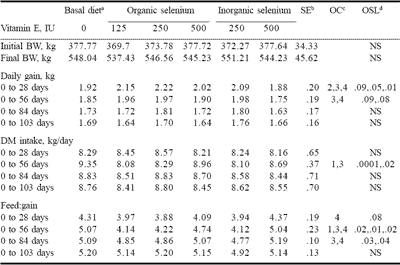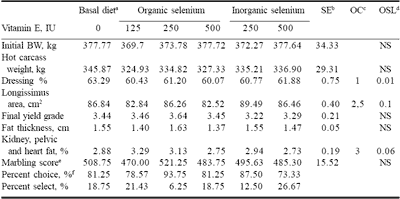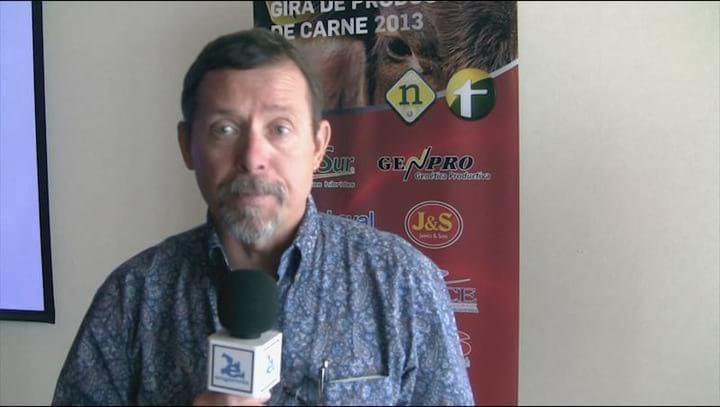Vitamin E levels and selenium form: effects on beef cattle performance and meat quality
Introduction
In 1987, the Food and Drug Administration (FDA) approved the addition of selenium (sodium selenite or sodium selenate) to all livestock diets at a 0.3 mg/kg concentration (Ullrey, 1992). Since that time, several changes have been made with regard to the level at which selenium can be administered in feeds for various animals. In August 1997 a final rule was published by the FDA that supports 3.0 mg/hd/d for beef cattle. There have been numerous reports about the clinical importance of selenium in the prevention of white muscle disease in ruminants (McDowell, 1992). However, few data are available on animal performance and carcass quality responses to dietary selenium in beef cattle.
Vitamin E has been recognized as an essential nutrient for growth and health of all species of animals (McDowell, 1989). The diverse roles of vitamin E are due to its involvement in nutritional myopathy, prostaglandin biosynthesis and immune responsiveness (Liu et al., 1995; Tengerdy, 1989).
Asghar et al. (1991) recorded improvements in animal performance when pigs were supplemented with 100 mg vitamin E/kg of feed. Selenium and vitamin E are nutritionally associated because of their relatively common deficiency symptoms. There have been a number of studies indicating a relationship between selenium and vitamin E in animal health (Van Ryssen et al., 1989; Weiss et al., 1990). However, there were also beneficial responses in carcass and sensory characteristics when selenium and/or vitamin E were included in the diet (Liu, et al., 1995; Cannon et al., 1996; Liu et al., 1996). The objectives of this research were to determine the effects of organic or inorganic selenium with vitamin E on performance and carcass characteristics of growing/finishing feedlot steers.
Materials and methods
Ninety-six Angus crossbred steers (374 kg) were utilized in an experiment to compare the effects of organic and inorganic selenium supplementation with different levels of vitamin E on performance and carcass characteristics. The feeding study was conducted at the Alltech Biotechnology research feedlot located at the Texas Tech University research farm on the southern high plains during the fall and winter of 1999.
Steers were randomly assigned by weight to 24 pens (four steers per pen and four pens per treatment) and fed for 103 days. Feed for each treatment was individually batched and delivered at approximately 0900 hrs each morning. Prior to feeding, feed remaining in the bunks was visually estimated and used to adjust feed amounts offered.
Typical feedlot diets used in this study were based on steam-flaked corn and 10% roughage from cottonseed hulls and chopped alfalfa hay (Table 1). All diets were formulated to meet requirements for crude protein, calcium, phosphorus, and vitamin A (NRC 1996). Selenium (Se) was added to supply 0 or 3 mg Se per head daily in the form of inorganic selenium (sodium selenite) or organic selenium yeast (Sel-Plex, Alltech Inc.). Vitamin E was added at either 125, 250 or 500 IU per head to provide the following dietary treatments:
Basal diet (no added vitamin E or selenium)
Basal diet plus 3.0 mg Se/head/day from Sel-Plex and 250 IU vitamin E
Basal diet plus 3.0 mg Se/head/day from selenite and 250 IU vitamin E
Basal diet plus 3.0 mg Se/head/day from Sel-Plex and 125 IU vitamin E
Basal diet plus 3.0 mg Se/head/day from selenite and 500 IU vitamin E
Basal diet plus 3.0 mg Se/head/day from Sel-Plex and 500 IU vitamin E
Individual animal weights were recorded at 28 day intervals during the experiment. Average daily gain (ADG), dry matter intake (DMI) and feed efficiency (feed:gain) ratios were calculated for each 28 day period. At the conclusion of the study, steers were transported to a commercial packing plant where final yield grade, dressing percentage, longissimus muscle area, quality grade, kidney, pelvic and heart (KPH) fat, and fat thickness were recorded by trained personnel.
Table 1.Ingredient composition (%) of the six experimental diets.
aTTU supplement formulated to meet NRC 1996 requirements for beef cattle containing cottonseed meal, calcium carbonate, dicalcium phosphate, potassium chloride, magnesium oxide, ammonium sulfate, salt, cobalt carbonate, copper sulfate, iron sulfate, EDDI, manganese oxide, zinc sulfate, vitamin A, Rumensin, and Tylan. Texas Tech University supplement contained no added selenium or vitamin E.
bSodium selenite premix 1 = 3 mg/hd/d.
cSel-Plex premix 1 = 3 mg/hd/d.
dVitamin E premix 0.25 = 125 IU/hd/d, .50 = 250 IU/hd/d, and 1 = 500 IU/hd/d of vitamin E.
Performance and carcass characteristics were analyzed with pen as the experimental unit. A completely randomized design was used, and computations were made with the GLM procedure of SAS (1987). The following five orthogonal contrasts were used to evaluate treatment effects:
1) Control vs the average of all other treatments;
2) Average of the organic vs the average of the inorganic selenium treatments;
3) Organic Se/125 IU vitamin E vs inorganic Se/500 IU vitamin E;
4) Organic Se/250 IU vitamin E vs inorganic Se/500 IU vitamin E
5) Organic Se/125 IU vitamin E vs inorganic Se/250 IU vitamin E.
Results and discussion
PERFORMANCE EFFECTS
Selenium source and supplemental vitamin E level did not affect overall performance of steers (Table 2). These results are consistent with those of Mahan and Parrett (1996), Ortman and Pehrson (1998) and Mahan et al. (1999), who demonstrated no overall growth or performance response to selenium form and various levels of vitamin E added to finishing swine diets. Nicholson et al. (1991) found no effect on daily gain or efficiency of calves supplemented with different selenium sources.
Table 2.Effects of vitamin E level and selenium source on performance of finishing beef steers.
aBasal diet = no added vitamin E or selenium.
bPooled standard error; n = four pens/treatment.
cOrthogonal contrasts: 1) control vs the average of all other treatments; 2) average of organic Se treatments vs average of inorganic Se treatments; 3) Sel-Plex/125 E vs selenite/500 E; 4) Sel-Plex/250 E vs selenite/500 E, and 5) Sel-Plex/125 E vs selenite/250 E. dOSL = observed significance level of orthogonal contrast; NS = non-significant, P>0.10.
While there were no significant differences for performance over the entire feeding period, orthogonal contrasts revealed differences during the growing period. During the first 28 days, cattle fed diets containing organic selenium had higher (P = 0.09) average daily gain compared to those fed inorganic selenium-supplemented diets. Improvements in daily gain were also detected for cattle given Sel-Plex plus either 125 (P = 0.05) or 250 IU (P = 0.02) vitamin E when compared to the group given inorganic selenium plus 500 IU vitamin E. Furthermore, at 56 days, cattle given Sel-Plex plus 125 or 250 IU vitamin E continued to have higher daily gains compared to those given inorganic selenium plus 500 IU vitamin E (P = 0.09 and 0.08, respectively).
Dry matter intake was similar among treatments, except at 56 days. Steers fed the unsupplemented control diet had higher dry matter intake (P = 0.0001) at 56 days when compared to the average of all other treatments. Furthermore, dry matter intake for cattle given Sel-Plex with 125 IU E decreased (P = 0.02) by 7% compared to the group receiving Sel-Plex with 500 IU vitamin E. At 56 days, steers on the unsupplemented basal diet had poorer feed efficiency (P = 0.02) when contrasted with the average of all other treatments. During the same period, improved efficiencies were noted for cattle given Sel-Plex with either 125 or 250 IU vitamin E (P = 0.01 and 0.02, respectively), when compared to those fed diets containing inorganic selenium and 500 IU vitamin E. Responses in efficiency were similar at 84 days with cattle given organic selenium and either 125 or 250 IU vitamin E being more efficient (P = 0.03 and P= .04) than cattle receiving inorganic selenium and 500 IU vitamin E. While the two organic selenium treatments were more efficient for the majority of the feeding study, in the last 21 days of the study there was a decline in daily gain which affected overall efficiency.
Cattle supplemented with organic selenium responded with an increase in performance for the first 56 days; however, selenium source and vitamin E level did not change performance over the entire experiment.
CARCASS CHARACTERISTICS
The same orthogonal contrasts used to compare means for performance were used to compare effects of treatments on carcass characteristics. Neither selenium source nor dietary vitamin E level influenced hot carcass weight, final yield grade, fat thickness, or marbling score (Table 3). While few differences were noted for carcass data among treatments, cattle fed the unsupplemented basal diet had higher (P = 0.01) dressing percentage when compared to the average of all other treatments. The Sel-Plex/125 IU E group had more KPH fat (P=0.06) than cattle given selenite/500 IU E. The average of the organic selenium treatments had lower LMA (P = 0.10) compared to the inorganic selenium treatments. No statistical analyses were performed on quality grade percentage; however, more cattle fed Sel-Plex/250 IU E graded Choice. On average, 83% of the cattle graded USDA Choice, with an average fat thickness of 1.49 cm, indicating that the cattle had reached the desired degree of finish by the end of the 103 day study.
Table 3.Effects of vitamin E level and selenium source on carcass characteristics of finishing feedlot steers.
aBasal diet = no added vitamin E or selenium.
bPooled standard error; n = four pens/treatment.
cOrthogonal contrasts: 1) control vs the average of all other treatments; 2) average of organic Se treatments vs average of inorganic Se treatments; 3) Sel-Plex/125 E vs selenite/500 E; 4) Sel-Plex/250 E vs selenite/500 E, and 5) Sel-Plex/125 E vs selenite/250 E.
dOSL = observed significance level of orthogonal contrast; NS = non-significant, P>0.10.
e300 = Slightº; 400 = Smallº; 500 = Modestº; 600 = Moderateº; 700 = Slightly abundantº.
fChoice % includes cattle that graded Prime.
Conclusions
While performance over the over the entire 103 days was unaffected, cattle supplemented with organic selenium showed improvements in performance during the high growth period. While supplementation of feedlot steers with inorganic selenium increased LMA, no differences were noted due to selenium source for other carcass variables measured. Animals supplemented with selenium and vitamin E had lower dressing percentage compared to animals that received no supplementation. Animals fed organic selenium and the lowest level of vitamin E had a larger percentage of KPH than all other treatments.
References
Authors: B.S. CLYBURN, C.R. RICHARDSON, M.F. MILLER, C.E. CLOUD, J.H. MIKUS and G.V. POLLARDAsghar, A., J.I. Gray, A.M. Boorman, E.A. Gommaa, M.M. Abouzied, E.R. Miller and D.J. Buckley. 1991. Effects of supranutritional dietary vitamin E levels on subcellular deposition of alpha-tocopherol in the muscle and on pork quality. J. Sci. Food Agric. 57:31.
Cannon, J.E., J.B. Morgan, G.R. Schmidt, J.D. Tatum, J.N. Sofos, G.C. Smith, R.J. Delmore and S.N. Williams. 1996. Growth and fresh meat quality characteristics of pigs supplemented with vitamin E. J. Anim. Sci. 74:98.
Liu, Q., M.C. Lanari and D.M. Schaefer. 1995. A review of dietary vitamin E supplementation for improvement of beef quality. J. Anim. Sci. 73:3131.
Liu, Q., K.K. Scheller, S.C. Arp, D.M. Schaefer and M. Frigg. 1996. Color coordinates for assessment of dietary vitamin E effects on beef color stability. J. Anim. Sci 74:106.
Mahan, D.C. and N.A. Parrett. 1996. Evaluating the efficiency of selenium- enriched yeast and sodium selenite on tissue selenium retention and serum glutathione peroxidase activity in grower and finisher swine. J. Anim. Sci. 74:2967.
Mahan, D.C., T.R. Cline and B. Richert. 1999. Effects of dietary levels of selenium enriched yeast and sodium selenite sources fed to growing-finishing pigs on performance, tissue selenium, serum glutathione peroxidase activity, carcass characteristics, and loin quality. J. Anim. Sci. 77:2172.
McDowell, L.R. 1989. Vitamin E. In: Vitamins in Animal Nutrition. Academic Press, Inc. San Diego.
McDowell, L.R. 1992. Selenium. In: Minerals in Animal and Human Nutrition. Academic Press, Inc. San Diego.
Nicholson, J.W.G., R.E. McQueen and R.S. Bush. 1991. Response of growing cattle to supplementation with organically bound or inorganic sources of selenium or yeast cultures. Can. J. Anim. 71:803.
NRC. 1996. Nutrient Requirements of Beef Cattle (7th Ed.) National Academy Press, Washington, DC.
Ortman, K and B. Pehrson. 1998. Selenite and selenium yeast as feed supplements to growing fattening pigs. J. Vet. Med. A 45:551.
SAS. 1987. SAS/STAT Guide for Personal Computers (Version 6th Ed.). SAS inst. Inc., Cary, NC.
Tengerdy, R.P. 1989. Vitamin E, immune response, and disease resistance. Ann. N. Y. Acad. Sci. 570:335.
Ullrey, D.E. 1992. Basis for regulation of selenium supplements in animal diets. J. Anim. Sci. 70:3922.
Van Ryssen, J.B.J., J.T. Deagen, M.A. Beilstein and P.D. Whemger. 1989. Comparative metabolism of organic and inorganic selenium by sheep. J. Agric. Food Chem 37: 1358.
Weiss, W.P., J.S. Hogan and K.L. Smith. 1990. Relationship among selenium, Vitamin E, and mammary gland health in commercial dairy herds. J. Dairy. Sci. 73:381.
Texas Tech University, Lubbock, Texas, USA





